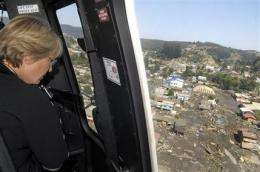Chile quake in 'elite class' like 2004 Asian quake

(AP) -- The huge earthquake that struck off the coast of Chile belongs to an "elite class" of mega earthquakes, experts said, and is similar to the 2004 Indian Ocean temblor that triggered deadly tsunami waves.
The magnitude-8.8 quake was a type called a "megathrust," considered the most powerful earthquake on the planet. Megathrusts occur when one tectonic plate dives beneath another. Saturday's tremor unleashed about 50 gigatons of energy and broke about 340 miles of the fault zone, according to the U.S. Geological Survey's National Earthquake Information Center.
The quake's epicenter was offshore and occurred about 140 miles north of the largest earthquake ever recorded - a magnitude-9.5 that killed about 1,600 people in Chile and scores of others in the Pacific in 1960.
"It's part of an elite class of giant earthquakes," said USGS geologist Brian Atwater.
If the magnitude holds, it will tie with the 1906 offshore Ecuador quake as the fifth largest since 1900.
"We call them great earthquakes. Everybody else calls them horrible," said USGS geophysicist Ken Hudnut. "There's only a few in this league."
The Chile quake was smaller than the Sumatra quake of 2004, a magnitude-9.1 and was not expected to be anything nearly as destructive. That quake and ensuing tsunami killed 230,000 people. Another difference is that the Chile quake triggered tsunami warnings hours ahead of time in Hawaii and Pacific islands, allowing people time to flee to higher ground.
In 2004, there was little measuring technology in place to warn Indian Ocean countries about incoming killer waves.
More than 100 aftershocks measuring magnitude-5 or larger rattled Chile throughout the day. So far, the quake death toll has surpassed 300 - a number that will likely rise. Several more died when tsunami waves swamped an island off the country's coast.
Chile is no stranger to violent jolts. In fact, USGS geophysicist Ross Stein called the country an "earthquake hatchery." Thirteen temblors of magnitude 7 or larger have hit Chile since 1973.
The latest quake took place at a boundary where two plates of the Earth's crust grind and dive. While that type of action gave rise to the Andes mountains that form the backbone of South America, it's also the source of some of the largest quakes.
The Chile temblor struck a day after a smaller earthquake shook the southern coast of Japan. Experts said the quakes appear to be unrelated.
There's also no connection between this quake and the disaster in Haiti, said University of Miami geology professor Tim Dixon.
A quake like the one that hit Haiti, a magnitude 7, happens somewhere in the world about every month, usually underwater. But the type that hit Chile is among the most powerful recorded in recent history.
The faults in Haiti and Chile are distant enough that stress from one would not affect the other, Dixon said.
©2010 The Associated Press. All rights reserved. This material may not be published, broadcast, rewritten or redistributed.



















